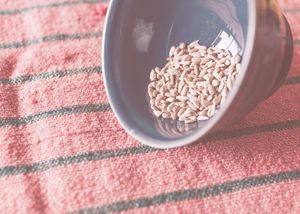My menstrual cycle has always been a bit, well, challenging. As a teen I was hospitalized for unexplained pains. They could have been due to my ongoing battle with gut dysbiosis, or perhaps the excruciating pinching feeling was down to ovulation pain – something I still experience to a lesser degree. I also have a short cycle and debilitating period pain.
My Naturopathic Doctor hoped that by fixing my gut, my hormones might follow suit. When that unfortunately didn’t happen, we ran some tests to confirm his suspicions of oestrogen dominance.
Oestrogen dominance simply means that the levels of oestrogen and progesterone are out of balance. My doctor believes that in my case, my body simply can’t clear the excess oestrogen from my system. Others may have a perfectly normal oestrogen level but don’t produce enough progesterone to balance things out, whereas others still might produce excess oestrogen.
There are two approaches to solving the issue. One is to bring down the level of oestrogen (which didn’t work for me). The other is to raise the level of progesterone to balance out the oestrogen spike (which is what I’m currently trying).
If you think you might be suffering from a hormone imbalance, I strongly recommend finding a health professional to help tailor a plan to suit you. I’m on a variety of different supplements, for example, but these were prescribed for my particular issue.
That said, there are some things you can safely and immediately add into your daily regime.
Seed Cycling First, there’s seed cycling. Specific seeds are said to support the optimal production of hormones during the first (follicular) and second (luteal) half of the menstrual cycle. If you don’t believe simple seeds can help, there’s no harm in trying. You’ll at least get a healthy dose of protein and fats.
The follicular phase, aka Day 1, is the first day of your menstrual cycle, when bleeding begins. The luteal phase – from ovulation through to the first day of bleeding – typically begins around halfway through your cycle. If you have a 28-day cycle, for instance, you’ll typically ovulate around day 14/15. Since I have a shorter cycle, mine is around day 12.
Follicular Phase: Day 1 to Day 14, or until ovulation 1 TBSP each x freshly ground organic raw flax seeds and pumpkin seeds daily
Luteal Phase: From Day 15 (or ovulation) to 28 (or until menstruation begins) 1 TBSP each x freshly ground organic raw sunflower seeds and sesame seeds daily
Storage Store seeds in the fridge or freezer, so they’re less likely to turn rancid.
Grinding Make sure you grind the seeds well; I use an electric spice grinder. Flax seeds and sesame seeds in particular can otherwise pass through the digestive tract whole, so you won’t get the benefits of eating them.
Serving I try to eat my serving of seeds at breakfast – otherwise I’d probably forget to do so. Most often I’ll sprinkle them over porridge or soaked oats, or mix them into a smoothie. The beauty is they can also be used to garnish savoury dishes, such as salads, soups or stir-fries.
After around six months at this quantity, I switched to 1 TBSP of one seed type on alternating days: Day 1: 1 TBSP x flax seed; Day 2: 1 TBSP x pumpkin seeds and so on.
Bitters and tea Supporting the liver is an important part of balancing hormones. On alternate days, I either take a serving of Swedish bitters with meals (twice a day) or drink a cup of my doctor’s GI Alternative tea, which is 0.5 part yellow dock, 2 parts burdock, 1 part dandelion and 0.5 part milk thistle.
Original photo by João Jesus from Pexels
